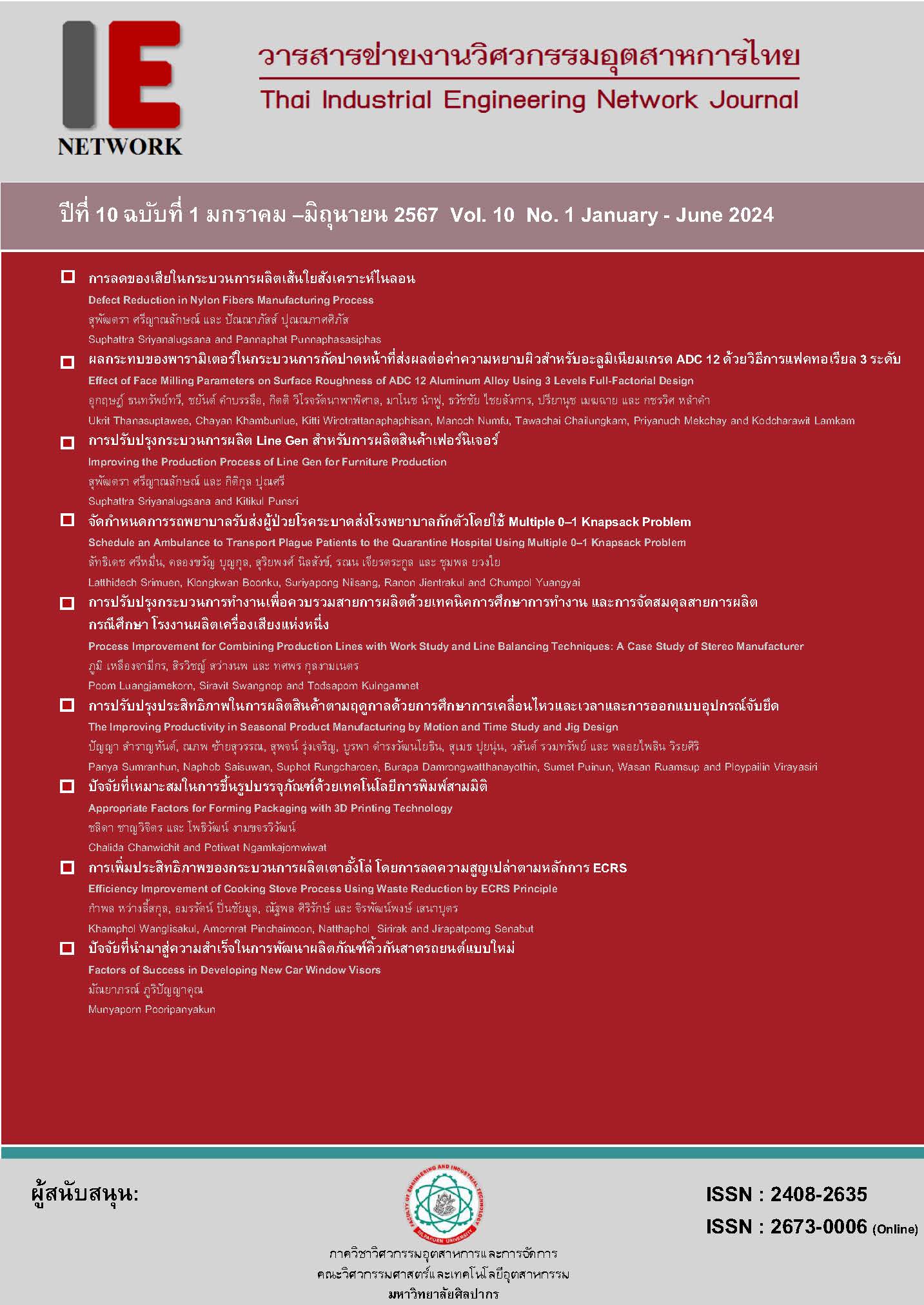Effect of Face Milling Parameters on Surface Roughness of ADC 12 Aluminum Alloy Using 3 Levels Full-Factorial Design
Main Article Content
Abstract
The purpose of this study aims to determine the influence of machining parameters which were consisted of three parameters; feed per tooth, cutting speed and depth of cut on surface roughness in CNC face milling process of ADC 12 aluminum alloy. The settings of machining parameters were conducted through 3 levels full-factorial design with 2 replicates. In addition, CNC machining center and carbide insert were fitted together with milling cutter which 63 millimeters of diameter, under wet cutting condition. The surface roughness of end-milled face was measured by the surface roughness tester. It was found that the most influence main factor was feed per tooth, followed by cutting speed. It was also found that interaction between cutting speed and feed per tooth, cutting speed and depth of cut as well as feed per tooth and depth of cut also impact the surface roughness. In contrast, Depth of cut was not affected on surface roughness at significant level of 0.05. Moreover, the minimum of surface roughness value was obtained with 800 m/min of cutting speed, 0.05 mm/tooth of feed rate and 0.6 mm of depth of cut which result 0.142 of Ra.
Article Details

This work is licensed under a Creative Commons Attribution-NonCommercial-NoDerivatives 4.0 International License.
บทความ ข้อมูล เนื้อหา รูปภาพ ฯลฯ ที่ได้รับการตีพิมพ์ในวารสารฯ ถือเป็นลิขสิทธิ์ของวารสารฯ หากบุคคลหรือหน่วยงานใดต้องการนำทั้งหมดหรือส่วนหนึ่งส่วนใดไปเผยแพร่ต่อหรือเพื่อกระทำการใดๆ จะได้รับอนุญาต แต่ห้ามนำไปใช้เพื่่อประโยชน์ทางธุรกิจ และห้ามดัดแปลง
References
Okayasu M, Miyatomo Y and Morinaka K. Material Properties of Various Cast Aluminum Alloys Made Using a Heated Mold Continuous Casting Technique with and without Ultrasonic Vibration. Metals 2015;5: 1440-1453.
Routara B. C., Bandyopadhyay, A., and Sahoo, P. Roughness modeling and optimization in CNC end milling using response surface method: effect of workpiece material variation. The International Journal of Advanced Manufacturing Technology 2009;40 (11-12): 1166-1180.
Benardos P. G. and Vosniakos G.-C. Prediction of surface roughness in CNC face milling using neural networks and Taguchi’s design of experiments. Robotics and Computer Integrated Manufacturing. 2002;18: 343–354
Lin T.-R. Optimisation Technique for Face Milling Stainless Steel with Multiple Performance Characteristics. The International Journal of Advanced Manufacturing Technology 2002;19: 330-335.
Bajić D, Celent L and Jozić S. Modeling of the Influence of Cutting Parameters on the Surface Roughness, Tool Wear and Cutting Force in Face Milling in Off-Line Process Control. Journal of Mechanical Engineering 2012;11: 673-682
Salehi M, Akbari J and Ravari H.R. OPTIMIZATION OF TOOL LIFE AND SURFACE QUALITY WHEN HIGH SPEED MILLING OF STAINLESS STEEL 420. 8th International Conference on High Speed Machining 2010.
Simunovic K, Simunovic G and Saric T. Predicting the Surface Quality of Face Milled Aluminium Alloy Using a Multiple Regression Model and Numerical Optimization. MEASUREMENT SCIENCE REVIEW 2013;5: 265-272


